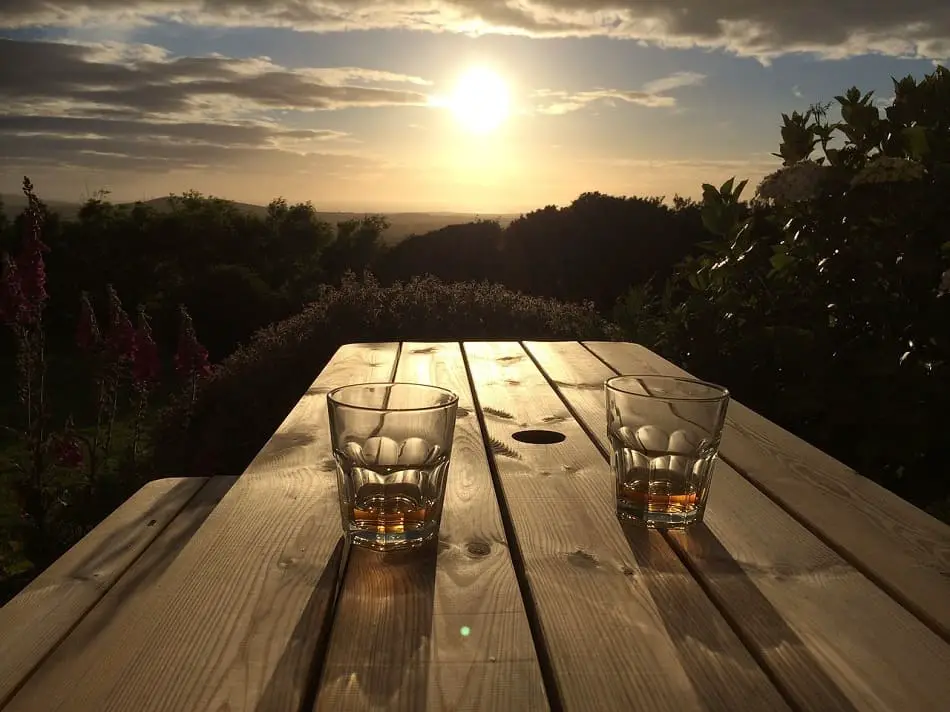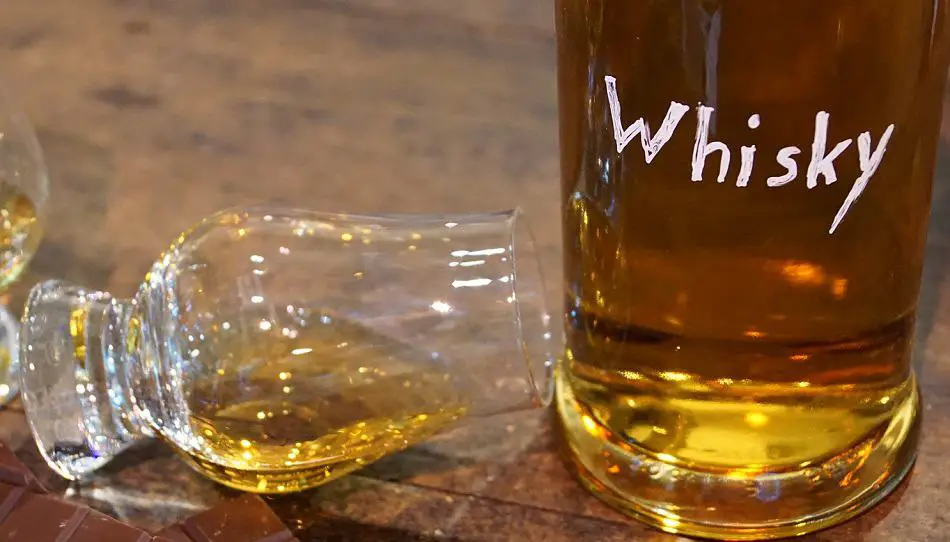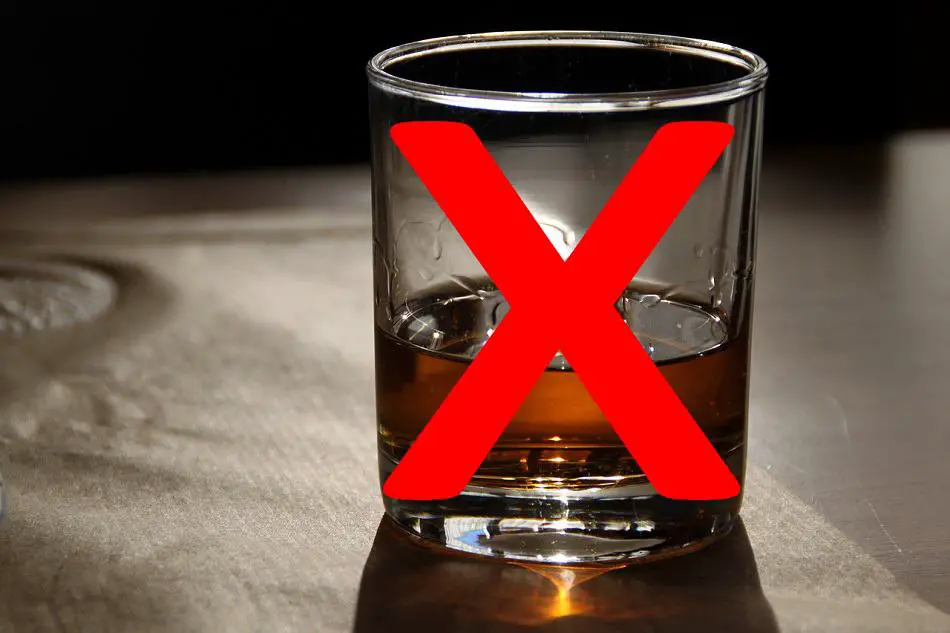Whiskey is not a drink that is consumed quickly, so it’s not surprising that occasionally people accidentally leave a glass of whiskey sitting out for hours, overnight or even a few days. Since it’s always a shame to waste whiskey, you’ll want to know how long it takes before a glass of whiskey that has been left out goes bad?
A glass of whiskey can be left out for 2 – 3 days before going bad. After that oxidation will change the flavor profile. A glass of whiskey left overnight will see some of the alcohol evaporating and therefore minute changes in the taste of the whiskey. Of course, if you leave the glass in direct sunlight it will go off much sooner.
The good news is, that it’s very difficult for whiskey to go bad. Even if oxidation does occur and you lose the original flavors of the whiskey, what you end up with might not be that bad. On the other hand, evaporation should make whiskey taste better which is why it’s a good idea to leave your glass of whiskey to sit out for an hour before drinking it!

Why Whiskey Doesn’t Go Bad
To start off with it’s useful to know that ordinarily, whiskey doesn’t go bad. This is because whiskey gets its flavor from the casks in which it’s matured, so once it’s bottled it can’t get any more flavor and will therefore stop ‘aging’. The fact that it has a high alcohol content (between 40 %ABV – 68%ABV) means the esters, congeners and volatile alcohols are frozen in a type of suspended animation which prevents it from going bad.
This is in contrast with wine that continues to age even in a sealed bottle and within about five years (for most wines, unless they’re of a very high quality) they will pass their expiry date, deteriorate (because the average AVB of wine is only 11.6% so the alcohol won’t help preserve it) and turn into vinegar.
The upshot of all this is that barring any freak occurrences or you doing something absurd to your whiskey, it’s highly unlikely to go bad, even if it’s left sitting out for a while. It’s not like other food or drink that goes bad relatively quickly and even quicker when left out.
What Happens to Whiskey That’s Been Left to Sit Out?
The biggest problem with letting a whiskey sit out is oxidation. Oxidation is the process of oxygen binding to one chemical compound and turning it into another. When oxygen gets into your whiskey it will change the compounds and therefore the flavor.
Oxidation occurs even in closed (but not sealed) bottles – although being closed means it takes longer, but if you leave a glass of whiskey sitting out it will oxidize within 2 – 3 days, after which the flavor of your whiskey will be permanently altered.

Precisely how the flavor of your whiskey will change can’t be predicted. It may be for the better, it may be for the worse. Either way it won’t be too terrible because even if oxidation makes your whiskey worse, it probably won’t make it undrinkable. It just won’t be as delicious as it would have been had it not been oxidized – a whiskey tragedy to be sure but not what we ordinarily mean by going bad.
The truth is that even leaving a glass of whiskey to sit out overnight may affect it, if enough evaporation has occurred by then.
This is because ethanol evaporates at a lower temperature than water, so the alcohol part of a whiskey will evaporate quicker than the water part. This means that evaporation causes the ABV of a whiskey to be reduced. Now this is not a bad thing. After all, we add water or ice to whiskey to dilute the alcohol so that it doesn’t stop us from tasting the whiskey and in order to open up new and more subtle flavors.
Evaporation has the same effect just via a different route.
Of course, it does mean that once again, the flavors will change so if you want the original ones then this will be something to avoid. But since some of the alcohol has evaporated your whiskey should taste better, being less alcoholic and more flavorful.
The only downside to evaporation is the reduction in the total amount of whiskey in the glass. Another whiskey tragedy – if you could actually detect the miniscule amount that has disappeared.
A last point on this is that a glass of whiskey can go cloudy if it has been left to sit out even just overnight. This doesn’t mean your whiskey has gone bad or is faulty or inferior. It just means that your whiskey won’t have the classic, glossy, golden look most people expect a whiskey to have.
Whiskey goes cloudy because it contains natural fatty acids, esters and proteins which dissolve in alcohol but not in water.
If the alcohol concentration decreases to a low enough level, that is less than 46%ABV, where there’s not enough alcohol to keep the fatty acids, esters and proteins together, they will un-dissolve, becoming separate from the alcohol. Since they are unable to dissolve in water, they will clump together in a special arrangement known as micelles and once there are enough of them, make your whiskey cloudy.
If the whiskey you left sitting overnight was close to 46%ABV it can easily evaporate in that time, reducing the alcohol level in the whiskey and making it cloudy. Fortunately, it’s easy to fix. Add some more whiskey and the increase in alcohol content will cause the fatty acids, esters and proteins to re-dissolve, the cloudiness to disappear and your whiskey’s original golden appearance to be restored.
When Whiskey That Has Been Left Sitting Out Does Go Bad

The unlikelihood of whiskey going bad is only true under normal circumstances. Exposure to direct light or sunlight or to certain environments can also affect a whiskey and possibly make it go bad. The same is true if the whiskey’s not neat. Let’s take a closer look.
Direct light or Sunlight. Direct light and worse direct sunlight catalyzes chemical reactions in the volatile compounds of the whiskey causing them to break down, and the flavor to degrade. At this point your whiskey will taste pretty bad. Also, the ultraviolet rays of direct sunlight will bleach out the color pigments of whiskey and discolor it.
In bottles this takes months, but of course with a small amount of whiskey in a glass this will occur much faster. How much will depend on the level of sunlight and how long your glass of whiskey has been left to sit in it.
Exposure to certain environments. The environment affects the taste of your whiskey. The temperature, humidity and other elements in the air can all cause its flavors to change. Try leaving a glass of whiskey overnight in a smoky area or coffee house and see if it doesn’t have an affect on the taste of the whiskey.
If you already added ice or water. If you already added ice or water to your whiskey and then left it to sit for a few days, the evaporation may cause your drink to lose its flavors. After all, while adding water does bring out the more subtle flavors this doesn’t continue indefinitely. At some stage you’ll simply be diluting your whiskey. Therefore, if you’ve already added water or ice, evaporation that comes from being left sitting out could in fact cause your whiskey to become too diluted.
This is not too much of a problem. Add a little more whiskey and your drink will return to being somewhat diluted. Not how it was out of the bottle but also not too diluted. You will have more whiskey in your glass than is usual for a single pour, but that problem is also one that’s easily overcome.
If the whiskey is part of a cocktail. If the whiskey is not neat but part of a cocktail, then your drink could indeed go bad and much sooner. However, this is because of the non-whiskey elements in the drink and what will happen to it will vary depending on the exact non-whiskey ingredients it contains.
Whiskey That’s Been Sitting for a Couple of Hours Gets Better
As already mentioned, when whiskey is left to sit out evaporation occurs, bringing out more flavors and making it taste better.
That’s why when a glass of whiskey is first poured it should be left to sit untouched, anywhere from a few minutes to a couple of hours. If you drink the whiskey as soon as it’s poured without giving it time to breathe, you’ll be losing out on some major aromas and flavors. Letting a whiskey sit allows the air to get to it so it can start to evaporate a little, reducing the level of alcohol and liberating all the whiskey’s flavors.
This also happens if you add water or ice, but the advantage to leaving it sit out for a while is that you don’t have to dilute your whiskey with water and become embroiled in the does-diluting-whiskey-with-water-dilute-its-flavor-or-not debate. The disadvantage is that you’ll have to wait a while before drinking your whiskey but if you really want to get all the flavors, it’s a price worth paying.
Some argue that whiskey should be left sitting out one minute for every year of its age, but you can’t go wrong if you wait a little longer. If somehow you find yourself with a glass of whiskey that has been left to sit for a couple of hours, you’ll probably find the aromas and flavors much more intense than usual.
